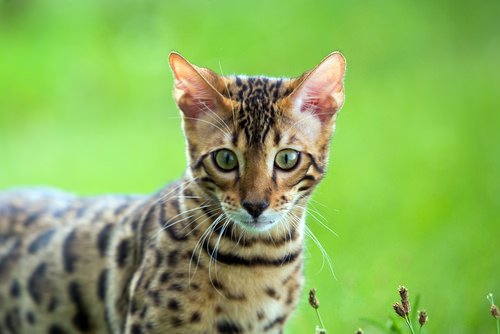By Mr. bhoyar
“Bengal cats are known for their striking appearance and energetic personalities. However, like any other breed, they are prone to certain health issues that every owner, including Mr. Bhoyar, should be aware of. In this article from catskitt.com, we’ll delve into the history and characteristics of the Bengal breed, discuss their life expectancy, and explore the common health problems they might face. Mr. Bhoyar will also provide essential care tips to ensure your Bengal cat leads a healthy and happy life.”
Table of Contents
The History of the Bengal Breed

The Bengal breed traces its roots back to the 1960s when breeders began crossing domestic cats with Asian leopard cats. This innovative breeding program aimed to create a domestic cat with a wild appearance. The result was the Bengal cat, characterized by its distinctive coat featuring striking spots and marbling reminiscent of its wild ancestors.
Characteristics of the Bengal Breed
Bengal cats are renowned for their unique appearance and active personalities. With their muscular build, sleek coat, and mesmerizing patterns, Bengals often resemble miniature wildcats. Their intelligent and curious nature makes them excellent companions, though they can also be quite demanding of attention and playtime.
What’s the Life Expectancy of a Bengal Cat?
On average, Bengal cats have a lifespan of around 12 to 16 years. With proper care and attention to their health needs, they can live long and fulfilling lives. Regular veterinary check-ups, a balanced diet, and plenty of mental and physical stimulation contribute to their overall well-being.
The 9 Common Bengal Cat Health Problems
1. Hypertrophic Cardiomyopathy (HCM)
Hypertrophic Cardiomyopathy, abbreviated as HCM, stands as a hereditary condition that exerts its influence on the muscles of the heart. This intricate ailment involves the thickening of the heart muscles, a phenomenon that gradually impedes the heart’s efficiency in pumping blood. As a result, the heart might struggle to function properly, leading to potential complications such as heart failure. With its genetic predisposition, Bengal cats can inherit this condition, necessitating vigilant monitoring and proactive care. Regular veterinary visits and diagnostic tests can help identify HCM early, enabling timely intervention and management strategies that can significantly enhance the quality and duration of your Bengal cat’s life.
2. Progressive Retinal Atrophy (PRA)
Progressive Retinal Atrophy, commonly referred to as PRA, is a concerning degenerative disorder that targets the retinas of the eyes. Over time, this ailment gradually erodes the retinal cells responsible for vision, leading to a progressive deterioration of eyesight. In advanced stages, PRA can result in total blindness. For Bengal cat owners, recognizing the early signs of vision problems and promptly seeking veterinary attention is vital. Regular eye examinations can aid in detecting PRA in its initial stages, enabling effective strategies to manage the condition and ensure your Bengal cat’s comfort and quality of life.
3. Patellar Luxation
Patellar luxation pertains to a condition where the kneecap becomes dislocated from its normal position. This displacement leads to discomfort and lameness, as well as an altered gait. While the exact cause of patellar luxation can vary, it’s crucial to address this issue promptly to alleviate pain and enhance mobility. Bengals, known for their agile nature, can be affected by this condition, potentially hindering their active lifestyle. Engaging your Bengal cat in regular exercise and maintaining a healthy weight can help mitigate the risk of patellar luxation. Consultation with a veterinarian can provide guidance on suitable preventive measures and treatment options if this issue arises.
4. Obesity
Despite their inherent activity and playfulness, Bengal cats can fall victim to obesity without proper exercise and dietary management. Obesity poses a range of health risks, including joint strain, diabetes, and heart problems. Engaging your Bengal cat in interactive play sessions and offering a well-balanced diet with appropriate portion control is essential. Monitoring their weight and body condition regularly allows you to make adjustments to their diet and activity level as needed. By preventing obesity, you can promote their overall well-being and ensure a healthy, happy life for your cherished feline friend.
5. Gastrointestinal Issues
Bengal cats might be more susceptible to gastrointestinal issues, including irritable bowel syndrome (IBS). Gastrointestinal problems can lead to symptoms such as vomiting, diarrhea, and discomfort. Identifying dietary triggers and making necessary adjustments can help manage these issues effectively. Providing a balanced and easily digestible diet, along with ample hydration, contributes to maintaining healthy gastrointestinal function. Consulting with a veterinarian can help determine the best approach for managing gastrointestinal problems in your Bengal cat, ensuring their comfort and minimizing potential complications.
6. Urinary Tract Problems
Certain Bengal cats are predisposed to urinary tract infections (UTIs) and blockages. Urinary tract issues can cause discomfort, pain, and even lead to life-threatening complications. Adequate hydration and a diet that promotes urinary health are key preventive measures. Additionally, maintaining a clean litter box encourages regular urination, reducing the risk of urinary problems. If you notice any changes in your Bengal cat’s urination habits or signs of discomfort, seeking prompt veterinary care is crucial to address urinary tract problems effectively and prevent recurrence.
7. Allergies
Skin allergies and sensitivities are not uncommon in Bengal cats. These allergies can manifest through symptoms like itching, scratching, and skin inflammation. Identifying the allergens causing these reactions is essential for managing the issue. In some cases, dietary adjustments might be necessary to alleviate allergic reactions. Environmental factors, such as pollen or household cleaning products, can also contribute to allergies. Working closely with a veterinarian to pinpoint the source of allergies and implementing suitable changes can provide relief for your Bengal cat and enhance their overall comfort and well-being.
8. Dental Issues
Dental hygiene is of paramount importance for Bengal cats to prevent gum disease and tooth decay. Neglected oral health can lead to painful conditions and affect their overall wellness. Regular brushing and providing dental treats can help maintain healthy teeth and gums. Additionally, scheduling regular dental check-ups with a veterinarian ensures any dental issues are detected early and addressed promptly. By prioritizing dental care, you contribute to your Bengal cat’s comfort and longevity.
9. Respiratory Infections
Bengals, like many other cat breeds, can be susceptible to upper respiratory infections (URIs). These infections can lead to symptoms such as sneezing, nasal discharge, and congestion. URIs are often caused by viruses and can spread easily among cats. Maintaining an indoor living environment can minimize exposure to potential sources of infection. If your Bengal cat exhibits signs of a respiratory infection, consulting with a veterinarian is essential for accurate diagnosis and appropriate treatment. Prompt care can aid in alleviating discomfort and preventing the spread of infections to other feline companions.
Caring for Your Bengal Cat
To ensure the well-being of your Bengal cat, follow these care tips:
- Provide a balanced diet rich in high-quality protein.
- Offer mental and physical stimulation through interactive play.
- Maintain regular veterinary visits for check-ups and vaccinations.
- Keep their litter box clean to prevent urinary issues.
- Monitor their weight and adjust their diet as needed.
- Groom their coat to prevent matting and hairballs.
- Create a safe indoor environment to protect them from potential hazards.
Conclusion
Owning a Bengal cat can be a rewarding experience, but it’s essential to be aware of their specific health concerns. By understanding their unique needs and providing attentive care, you can ensure your Bengal cat lives a healthy and joyful life by your side.
Related post
9 Ragdoll Cat Health Issues, You Need to Be Worried About (catskitt.com)
9 Persian Cat Health Issues, You Need to Be Worried About (catskitt.com)
9 Maine Coon Cat Health Issues I You Need to Be Worried About (catskitt.com)
Siamese Cat Health Issues: 9 Critical Things to Watch Out For (catskitt.com)
FAQs
1. Are Bengal cats more prone to specific health issues?
Yes, Bengal cats can be susceptible to conditions like HCM, PRA, and gastrointestinal problems.
2. Can Bengal cats live outdoors?
It’s safer to keep Bengal cats indoors to protect them from potential dangers and health risks.
3. How often should I take my Bengal cat to the vet?
Regular veterinary check-ups should occur at least once a year, or as recommended by your vet.
4. Do Bengal cats require a special diet?
While they don’t require a unique diet, a high-protein, balanced diet is essential for their well-being.
5. Are Bengal cats suitable for families with children?
Yes, Bengal cats can be great family companions, but proper supervision and interaction are necessary.
Sources
1. Cat Fanciers’ Association. “Bengal Cats.” [https://cfa.org/bengal/](https://cfa.org/bengal/)
2. The International Cat Association. “About Bengals.” [https://www.tica.org/bengal-about](https://www.tica.org/bengal-about)
